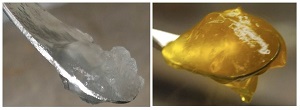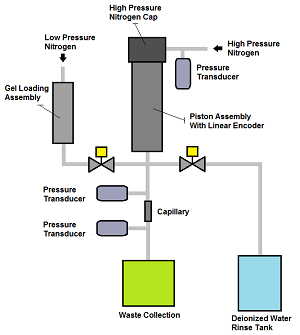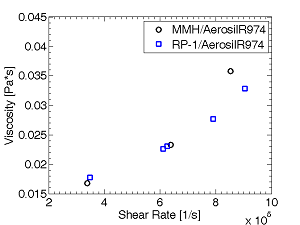Gelled Propellant Rheology
Overview
This effort, funded by the Army Research Office (ARO) MURI grant, seeks to understand the rheological properties of non-Newtonian gelled hypergolic propellants. Monomethylhydrazine (MMH), red fuming nitric acid (RFNA) and representative inert simulants have been the primary focus of this effort. Characterization is performed with a commercial rotational rheometer and a custom propellant grade capillary rheometer.
Capabilities
- Characterization of gelled propellants from low shear storage to high shear injection conditions.
- Propellant-Grade Capillary Rheometer:
- Designed system to reduce risks to personnel and equipment when testing with toxic materials.
- Capable of typical rocket injector shear rates up to 1,000,000 1/s with variable capillary geometry.
- Commercial Rotational Rheometer:
- Operation in a laboratory fume hood for toxic propellant handling.
- Low shear viscometry, yield stress and frequency dependent measurements.
- Refrigerated Centrifuge:
- Evaluation of gel stability over a range of temperatures (-9°C to 40°C).
- Accelerated settling studies for energetic additives in propellants.
Accomplishments
- Identification of key rheological properties for a viable gelled hypergolic propellant.
- Measurement of gel viscosity at shear rates typical of rocket injectors.
- Standard assumption is that high shear gel viscosity is equal to the base fluid.
- Results indicate that even at 6% loading the fumed silica properties dominate the gel viscosity.
- Gel viscosity ~14 times higher than base fluid at high shear rates.
- Demonstrated that less toxic gel simulants can match the rheological properties of MMH gels allowing for experimentation with reduced risk.
People
Faculty
, Purdue University , Purdue University
Researchers
, M.S. (Graduated)
, M.S. (Graduated)
, M.S. (Graduated)
, Ph.D. (Graduated)


